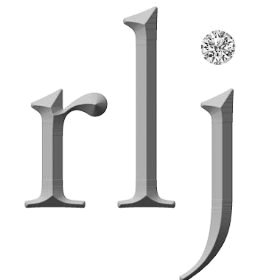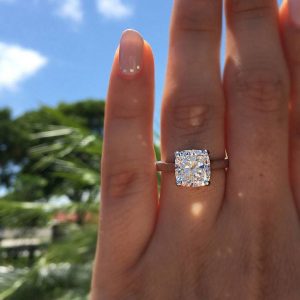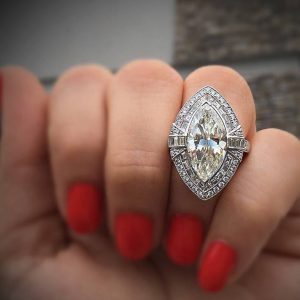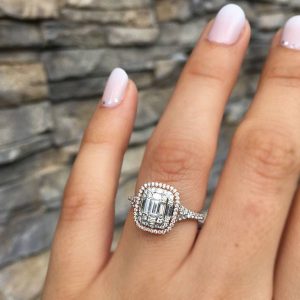Moissanite Engagement Rings: What You Need to Know
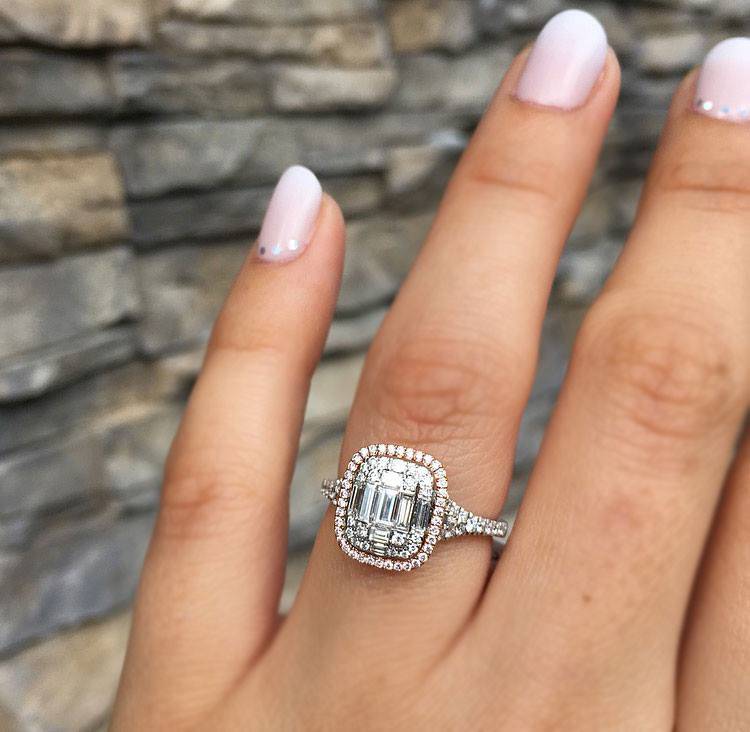
Moissanite is a naturally occurring gemstone that’s trending upward in the bridal market. As brides explore different options for getting their dream ring, whether it’s with an alternative center stone or by taking advantage of wedding ring financing, plenty of today’s couples are thinking outside the diamond (though, we have to tell you, Millennials are still buying diamonds.)
Moissanite and Cubic Zirconia are the most popular diamond simulants due to:
- Pricing – they’re both a lot less than a diamond
- Sustainability – they’re lab-created, so even compared to the most responsibly and ethically sourced diamonds, their pedigree is hard to beat.
- Responsibility- again, related to price, if you’re the type who constantly loses earrings and bracelets, maybe a diamond isn’t the best option for you.
While most of our settings at Diamonds by Raymond Lee are set with placeholder Cubic Zirconia (except for our Henri Daussi rings) we’ve seen a growing interest in Moissanite. Let’s talk about this gemstone.
Moissanite
While it’s growing in popularity, Moissanite has actually been around since the late 19th century, when it was discovered in 1893 by the French scientist Henri Moissan (get it? Moissanite!) Moissan discovered a crater in Arizona shining with what he thought were diamonds. Unfortunately, after testing he realized their chemical composition included silicon carbide – not the pure carbon that makes up diamonds.
But while the crater wasn’t filled with diamonds, its strikingly similar looking gems were still a hot commodity. And because meteorite craters filled with Moissanite are somewhat hard to find, most of the Moissanite found in today’s jewelry is lab-created, using the same chemical formula found in Henri’s discovery.
Moissanite vs. Diamond
While Moissanite, by design, mimics a diamond’s beauty very well, the two are entirely different gemstones:
- Hardness – a Moissanite rates 9.25 on the Mohs scale. Higher than sapphires! A diamond is a 10 (the hardest), so even this hardness level still comes close to the virtually indestructible diamond, making Moissanite a great option for everyday wear (as opposed to other diamond simulants like Cubic Zirconia.)
- Brilliance – Technically, a Moissanite is more brilliant than a diamond, with increased light dispersion and more fire (click here to learn more about these terms.) A diamond’s facets give it not only brilliance, but also fire and scintillation (different ways that it reflects and refracts light.) A diamond will have slightly less colorful flashes, and more black and white (scintillation.)
- Color – Moissanite, were it graded by GIA would likely be around an H color. It’s got a tinge of warmth to it that is absent from the colorless grades and near colorless diamonds. Diamonds have a greater range in colors, with grades from D-Z on the colorless scale and fancy colors in every shade of the rainbow (though those will cost you a premium.)
- Price – Moissanite is much less expensive than a diamond for several reasons. First, Moissanites are measured in millimeters, where diamonds are measured in carat weight. You can’t compare two by weight because their different chemical makeup gives them very different density. A 1 carat diamond would be closest to a 6.5mm Moissanite. Because of this different metric, there’s not a pricing structure like diamonds have (click here to read more about diamond prices and how they’re determined. ) Regardless of how the price is determined, Moissanite is much less expensive than diamonds, think $6000 vs. $600.
What You Need to Know About Moissanite
Buying a Moissanite stone that looks convincingly like a diamond is easy with a few tips:
- Shape: Stick to Round Brilliant Moissanites – the faceting pattern hides the inherent color of a Moissanite well and will also minimize the appearance of any scratches the Moissanite gets over time.
- Stay under 2 carats. The larger the Moissanite, the more obvious it becomes that it’s not a diamond.
- Remember that you’re buying a diamond simulant! While it is designed to look like a diamond (and it gets pretty close) a Moissanite is not the same thing and won’t perform the way your diamond would. If your greatest aim is to save money, you will with a Moissanite, but you’ll miss out on the mysterious beauty that only a diamond can give you.
